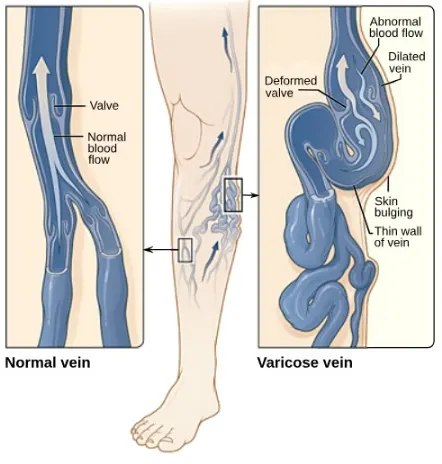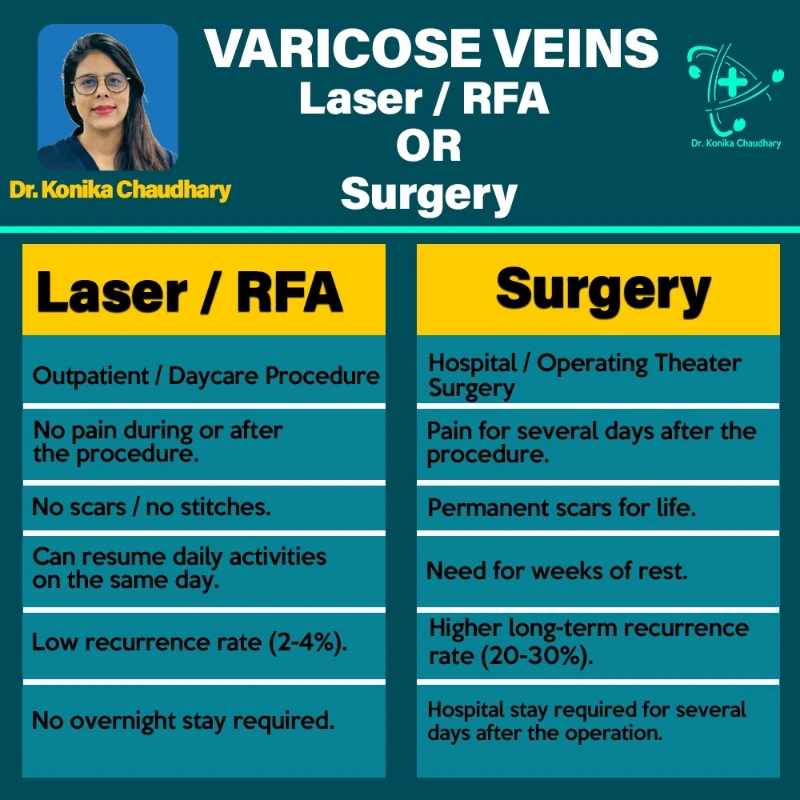Varicose Vein
Varicose veins are enlarged, twisted veins that usually appear in the legs and feet. These veins become visibly bulging and may appear dark blue or purple due to the pooling of blood within them.

Varicose veins are a diverse vascular condition ranging from the appearance of early spider veins on the skin to the development of tortuous, dilated superficial veins and complex venous disorders that may lead to non-healing ulcers. Often overlooked until symptoms arise, varicose veins can cause discomfort, including throbbing pain, fatigue, and leg heaviness, significantly impacting one’s quality of life.
The Expert: Dr. Konika Chaudhary
In the pursuit of providing optimal care for her patients, Dr. Konika Chaudhary offers state-of-the-art non-surgical treatments, such as Endovenous RFA (Radiofrequency)/ LASER ablation therapy. Historically, outdated surgical methods and older LASER machines have yielded unsatisfactory results in many cases. Dr. Chaudhary takes responsibility for delivering a simple, risk-free, and efficient procedure that allows patients to regain their normal lives swiftly and in better health.
Symptoms of Varicose Veins

- Spider Veins: Tiny, twisted veins visible just below the skin’s surface.
- Discolored Veins: Large, blue or purple veins that appear on the skin’s surface.
- Swelling: Swelling in the ankles and feet.
- Aching Legs: Persistent leg pain with a “heavy” feeling.
- Muscle Cramps: Cramping in the calf muscles, particularly at night.
- Itchy Skin: Itching in the affected areas, often concentrated on the lower legs and ankles.
- Skin Changes: Skin in the affected area may exhibit mild discoloration or the appearance of faint spots.
- Venous ulcers
Root Causes of Varicose Veins
The primary cause of varicose veins is the malfunctioning of valves within the veins. This malfunction leads to the pooling of blood, which, in turn, causes the veins to enlarge and become distorted. Prolonged periods of standing exacerbate this condition, damaging the vein walls and contributing to vein enlargement.

The Risks of Untreated Varicose Veins
Neglecting the treatment of varicose veins can lead to various complications, including:
- Leg Discomfort: Persistent leg heaviness and pain.
- Itching: Pruritus (itching) in the affected areas.
- Skin Discoloration: Brownish pigmentation in the lower leg region.
- Bleeding: Rupture of enlarged veins can result in bleeding.
- Non-Healing Ulcers: The most severe complication, non-healing ulcers, can develop.

Cutting-Edge Treatment by Dr. Konika Chaudhary
All procedures performed by Dr. Konika Chaudhary are conducted under ultrasound guidance, ensuring precise mapping of affected veins and yielding superior outcomes. Dr. Chaudhary’s in-depth expertise in venous issues empowers patients to make informed decisions regarding their treatment.
- RFA (Radiofrequency Ablation)
- Endovenous laser ablation
- Venaseal / Superglue
- Sclerotherapy and perforator ablation

Advantages of Interventional Radiology – A Minimally Invasive Approach
- Nonsurgical: No incisions, sutures, or scarring.
- No General Anesthesia: Procedures can be performed without general anesthesia.
- Shorter Recovery: Faster recovery times compared to traditional surgical methods.
- Daycare Procedure: Patients can return home on the same day.
- Single-Stage Treatment: Multiple veins can be addressed in a single session, streamlining the process.
In summary, Dr. Konika Chaudhary’s commitment to advanced, minimally invasive treatments for varicose veins ensures that patients receive the highest quality care with the least disruption to their lives. Early diagnosis and timely intervention can help individuals regain their leg health and overall well-being.
Patient
Testimonial


Frequently asked Questions ( FAQ ) on Varicose Veins
A1: Varicose veins can present in a wide spectrum of forms, ranging from early spider veins on the skin’s surface to the development of tortuous, dilated superficial veins and complicated venous diseases leading to non-healing ulcers.
A2: People often overlook varicose veins until problems develop because it’s a common ailment. Left untreated, varicose veins can cause painful symptoms such as throbbing pain, fatigue, and a heavy sensation in the legs, significantly impacting one’s quality of life.
A3: Dr. Konika Chaudhary specializes in providing patients with the most advanced non-surgical treatment called Endovenous RFA (Radiofrequency) and superglue injection (venaseal).
A4: Common symptoms of varicose veins include swollen, twisted veins beneath the skin’s surface, visible bluish or purplish bulging veins, swelling in the ankles and legs, achy and heavy legs, muscle cramps, itching, a burning sensation, and skin discoloration in the affected area.
A5: Varicose veins primarily develop due to malfunctioning valves in the veins, causing blood to accumulate and distort the veins. Prolonged standing is a significant factor that damages vein walls and leads to their enlargement.
A6: Leaving varicose veins untreated can result in various risks, including leg heaviness and pain, itching, brownish pigmentation in the lower leg, bleeding from ruptured veins, and the most severe complication, non-healing ulcers.
Ans – The advantages of Interventional Radiology Minimally Invasive Procedures include a non-surgical approach with no sutures or scars, no requirement for general anesthesia, faster recovery times, outpatient procedures, and the ability to treat multiple veins in a single session, making it a convenient and effective option for patients.
Get One Step Ahead Of Disease
Imperdiet aliquet est vel nulla turpis eu consequat ullamcorper a egestas suspendisse faucibus eu velit, phasellus pulvinar lorem et libero et tortor, sapien nulla.
Subsribe To Our Newsletter
Stay in touch with us to get latest news and special offers.
Vascular Clinic
Shekhar Sarraf Memorial Hospital, Aligarh Vishal Imaging Centre, Aligarh
Call Us
+91-9548752611
Email Us
konikachaudhary8@gmail.com
